TOYOTA PRIUS C 2013 NHP10 / 1.G Owners Manual
Manufacturer: TOYOTA, Model Year: 2013, Model line: PRIUS C, Model: TOYOTA PRIUS C 2013 NHP10 / 1.GPages: 556, PDF Size: 8.88 MB
Page 241 of 556
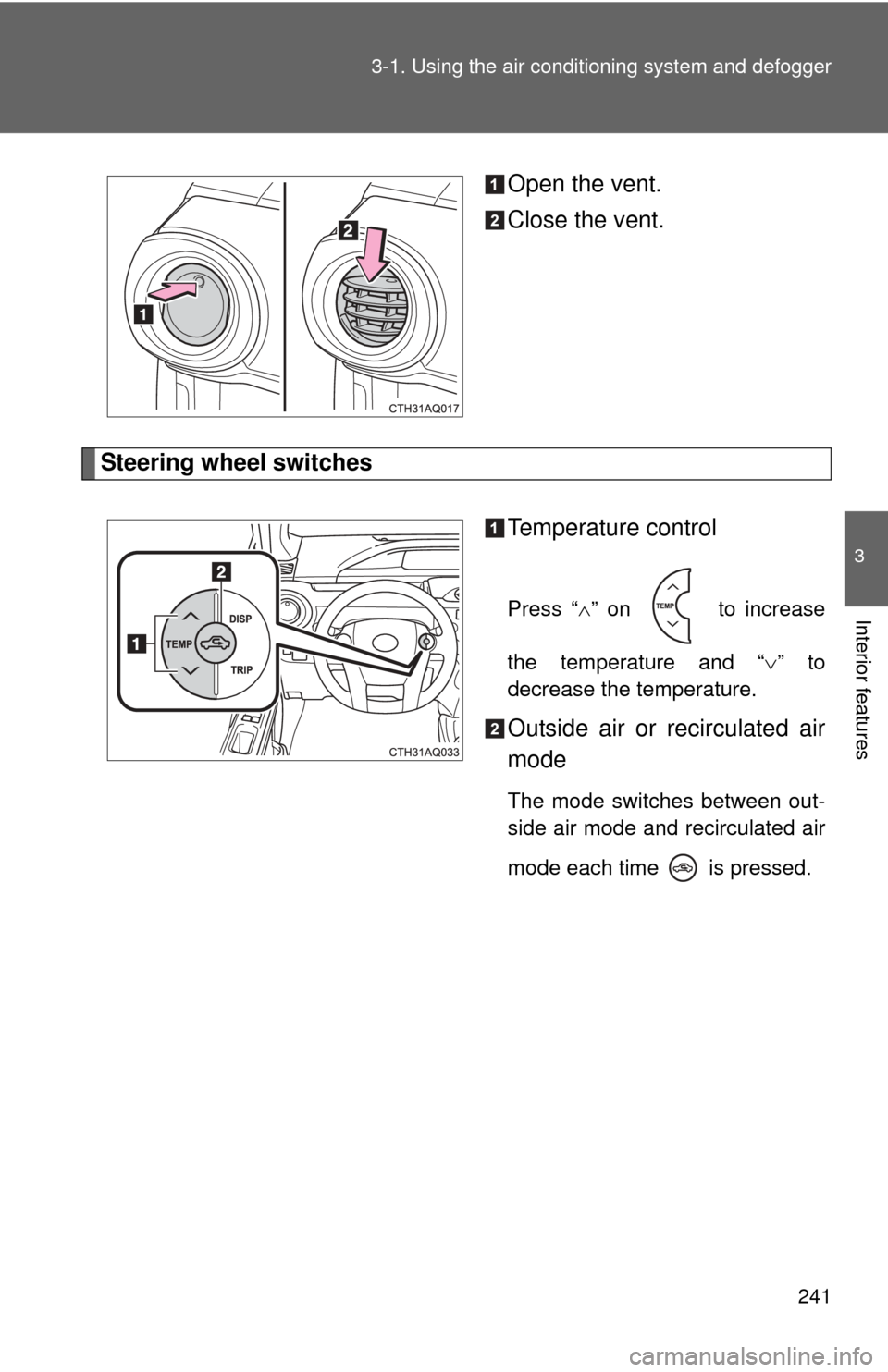
241
3-1. Using the air conditioning system
and defogger
3
Interior features
Open the vent.
Close the vent.
Steering wheel switches
Temperature control
Press âïâ on to increase
the temperature and â ïâ to
decrease the temperature.
Outside air or recirculated air
mode
The mode switches between out-
side air mode and recirculated air
mode each time is pressed.
Page 242 of 556
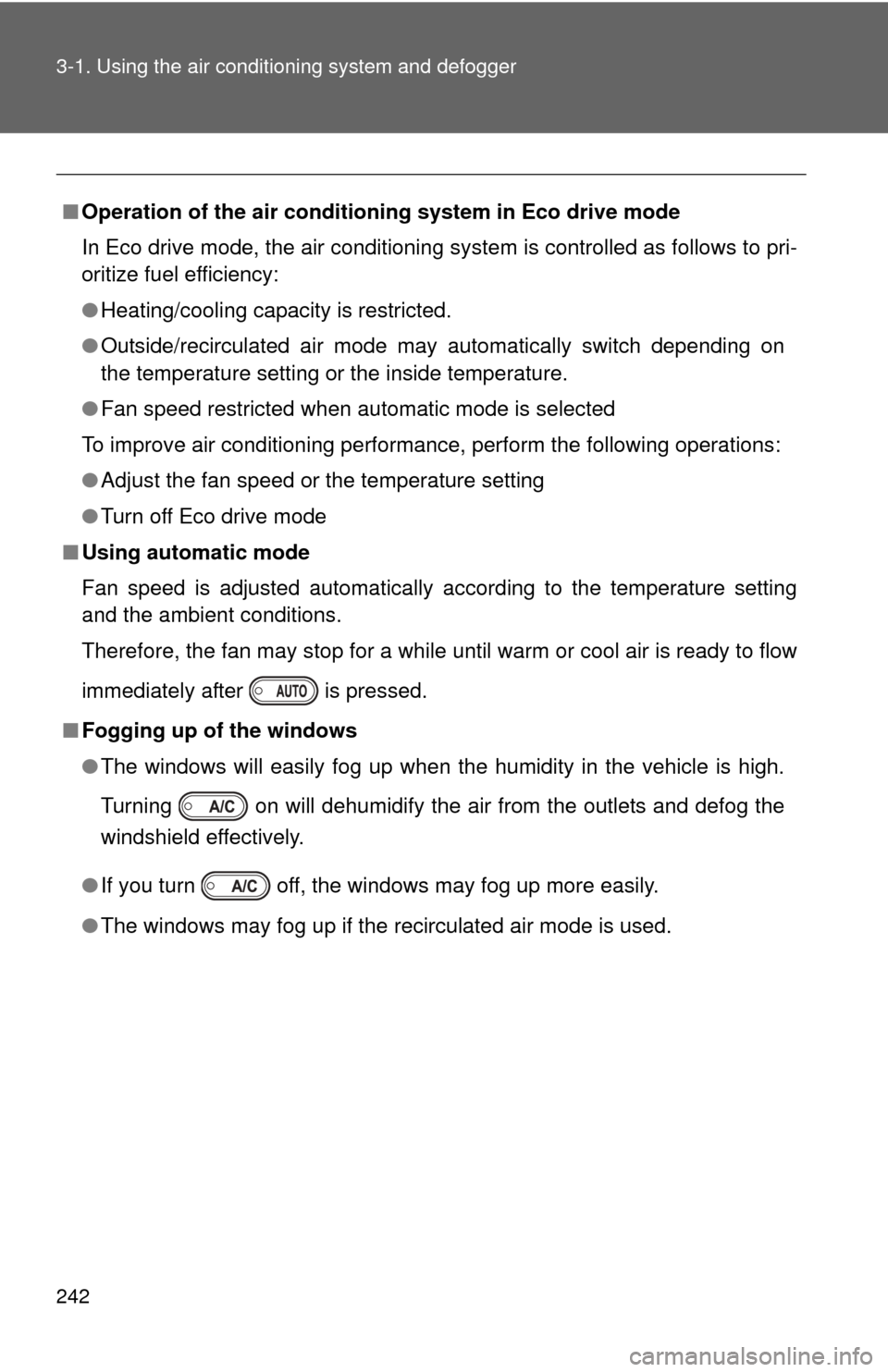
242 3-1. Using the air conditioning system and defogger
â Operation of the air conditio ning system in Eco drive mode
In Eco drive mode, the air conditioning system is controlled as follows to pri-
oritize fuel efficiency:
â Heating/cooling capacity is restricted.
â Outside/recirculated air mode may automatically switch depending on
the temperature setting or the inside temperature.
â Fan speed restricted when automatic mode is selected
To improve air conditioning performance, perform the following operations:
â Adjust the fan speed or the temperature setting
â Turn off Eco drive mode
â Using automatic mode
Fan speed is adjusted automatically according to the temperature setting
and the ambient conditions.
Therefore, the fan may stop for a while until warm or cool air is ready to flow
immediately after is pressed.
â Fogging up of the windows
âThe windows will easily fog up when the humidity in the vehicle is high.
Turning on will dehumidify the air from the outlets and defog the
windshield effectively.
â If you turn off, the windows may fog up more easily.
â The windows may fog up if the recirculated air mode is used.
Page 243 of 556
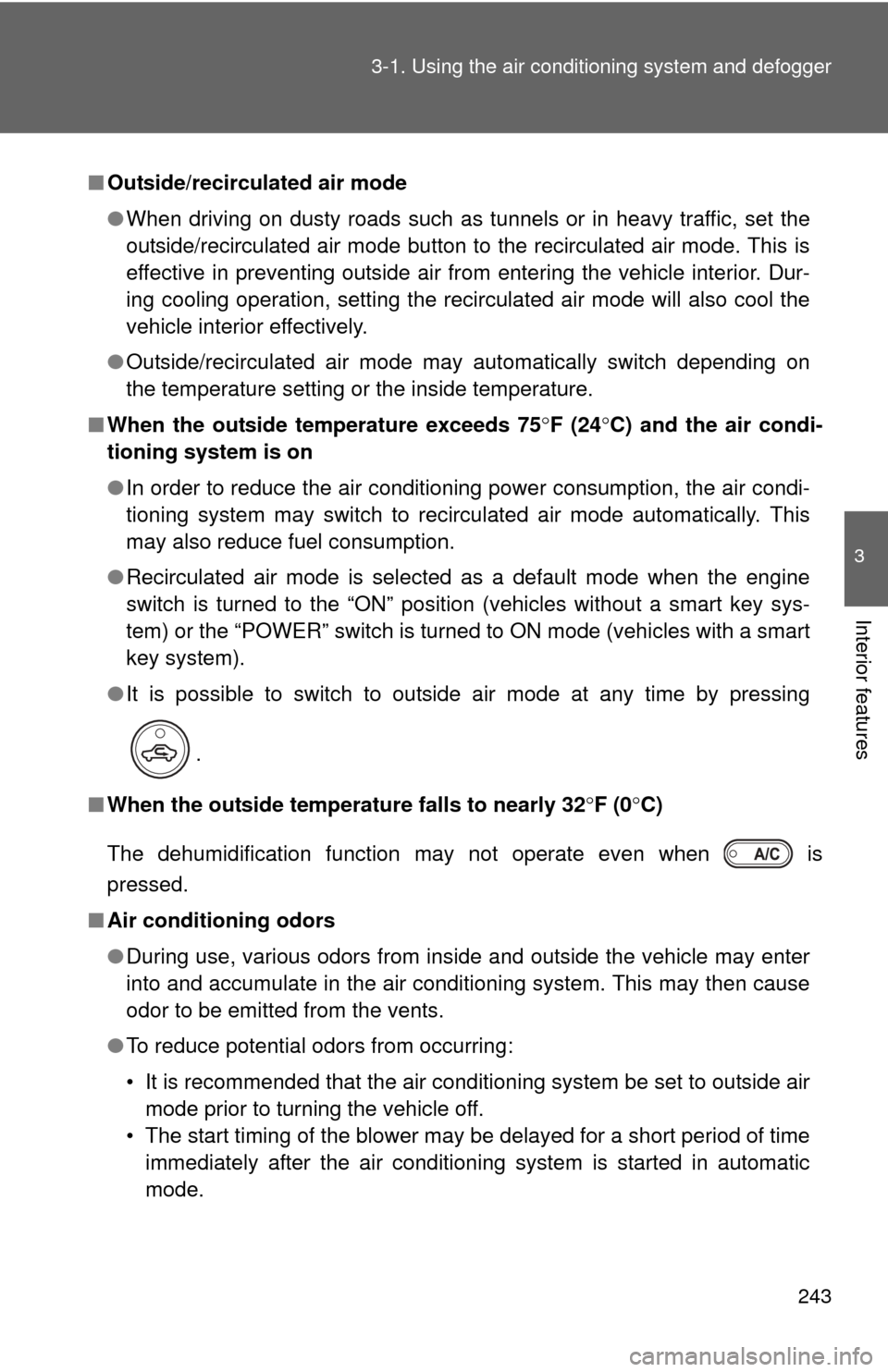
243
3-1. Using the air conditioning system
and defogger
3
Interior features
â Outside/recirculated air mode
âWhen driving on dusty roads such as tunnels or in heavy traffic, set the
outside/recirculated air mode button to the recirculated air mode. This is
effective in preventing outside air from entering the vehicle interior. Dur-
ing cooling operation, setting the recirculated air mode will also cool the
vehicle interior effectively.
â Outside/recirculated air mode may automatically switch depending on
the temperature setting or the inside temperature.
â When the outside temperature exceeds 75ï° F (24ï°C) and the air condi-
tioning system is on
â In order to reduce the air conditioning power consumption, the air condi-
tioning system may switch to recirculated air mode automatically. This
may also reduce fuel consumption.
â Recirculated air mode is selected as a default mode when the engine
switch is turned to the âONâ position (vehicles without a smart key sys-
tem) or the âPOWERâ switch is turned to ON mode (vehicles with a smart
key system).
â It is possible to switch to outside air mode at any time by pressing
.
â When the outside temperature falls to nearly 32 ï°F (0 ï°C)
The dehumidification function may not operate even when is
pressed.
â Air conditioning odors
âDuring use, various odors from inside and outside the vehicle may enter
into and accumulate in the air conditioning system. This may then cause
odor to be emitted from the vents.
â To reduce potential odors from occurring:
⢠It is recommended that the air conditioning system be set to outside air
mode prior to turning the vehicle off.
⢠The start timing of the blower may be delayed for a short period of time immediately after the air conditioning system is started in automatic
mode.
Page 244 of 556
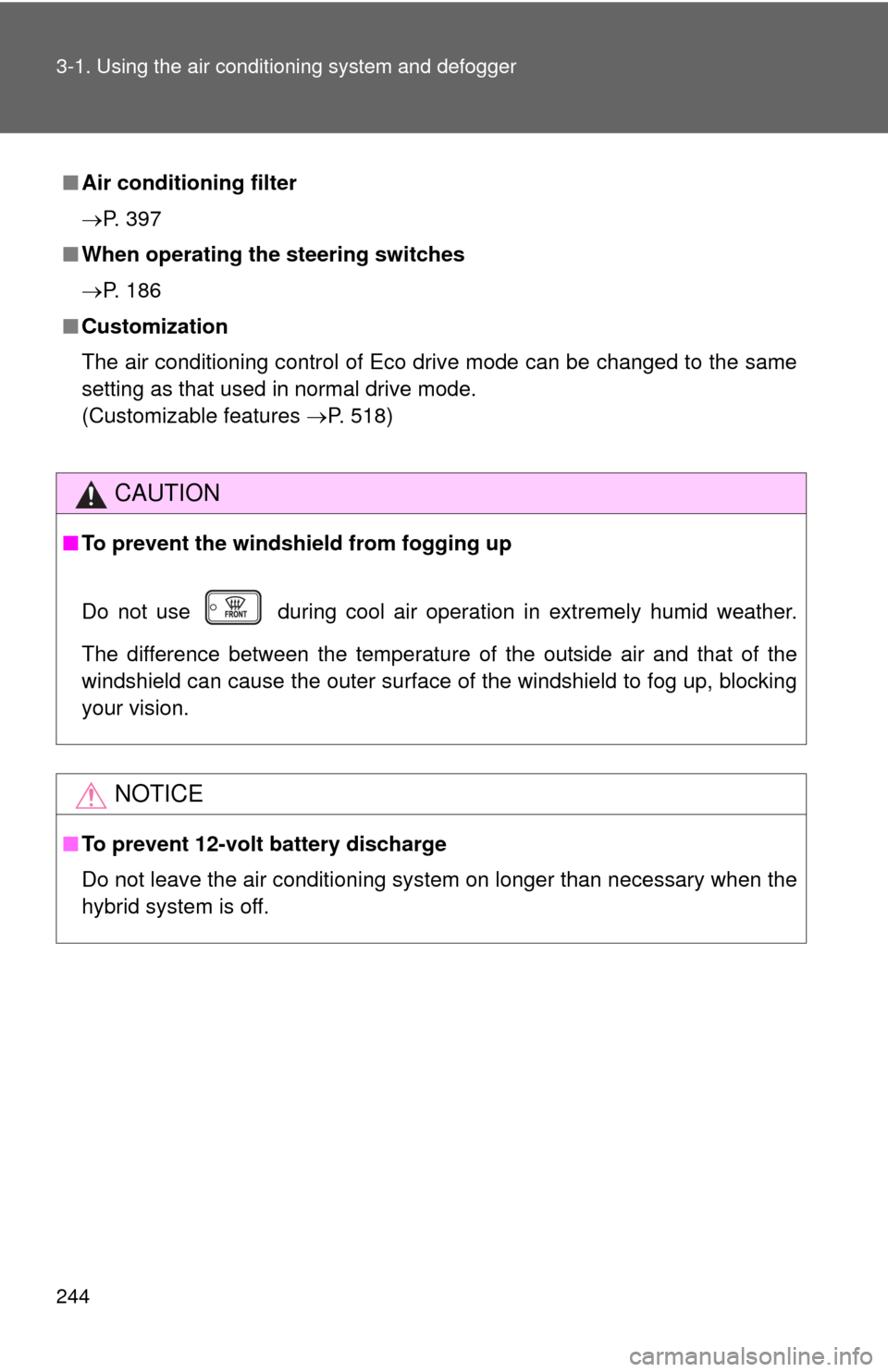
244 3-1. Using the air conditioning system and defogger
â Air conditioning filter
ï®P. 397
â When operating the steering switches
ï®P. 186
â Customization
The air conditioning control of Eco drive mode can be changed to the same
setting as that used in normal drive mode.
(Customizable features ï®P. 518)
CAUTION
â To prevent the windshield from fogging up
Do not use during cool air operation in extremely humid weather.
The difference between the temperature of the outside air and that of the
windshield can cause the outer surface of the windshield to fog up, blocking
your vision.
NOTICE
â To prevent 12-volt battery discharge
Do not leave the air conditioning system on longer than necessary when the
hybrid system is off.
Page 245 of 556
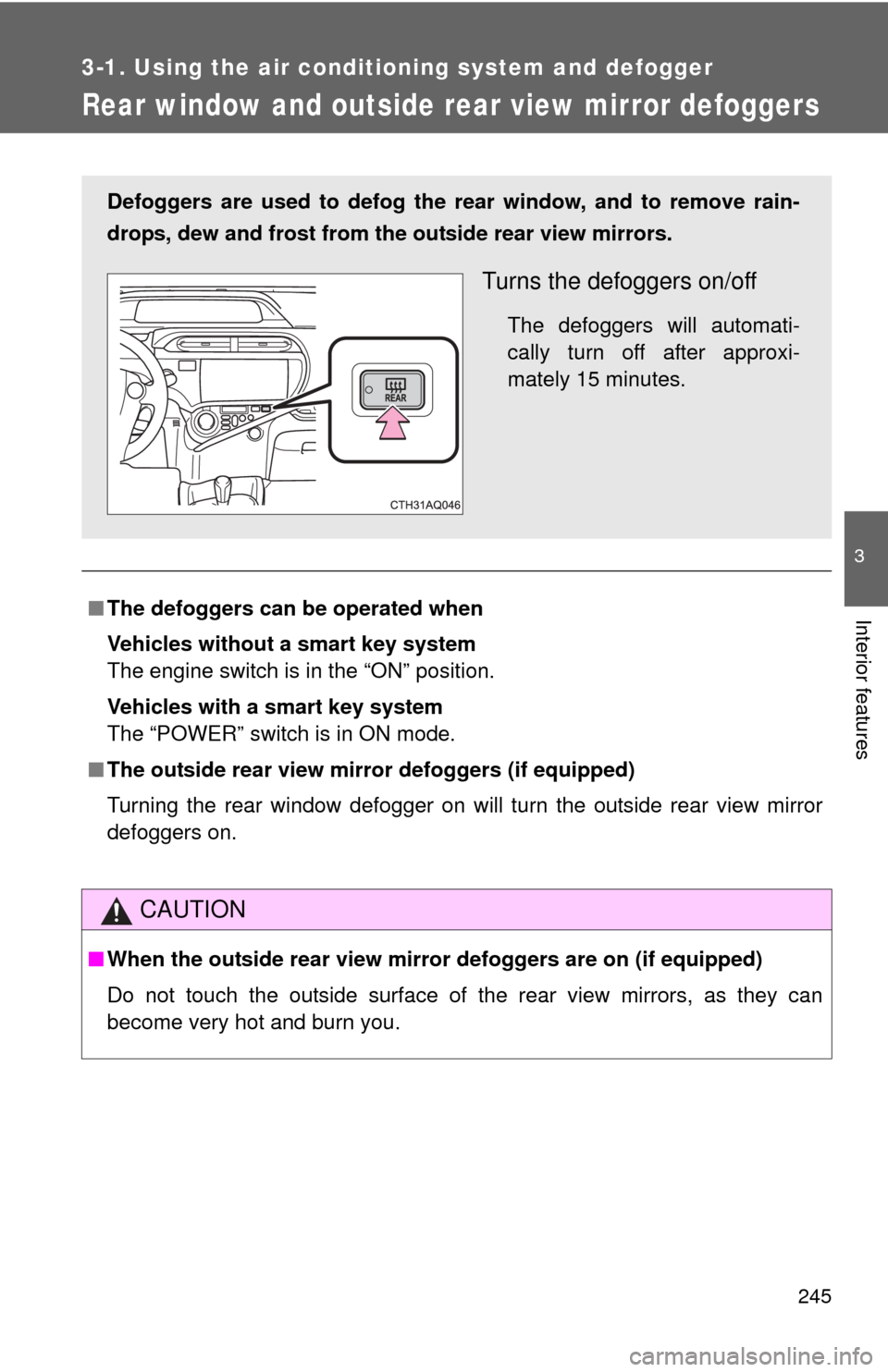
245
3-1. Using the air conditioning system and defogger
3
Interior features
Rear window and outside rear view mirror defoggers
â The defoggers can be operated when
Vehicles without a smart key system
The engine switch is in the âONâ position.
Vehicles with a smart key system
The âPOWERâ switch is in ON mode.
â The outside rear view mirr or defoggers (if equipped)
Turning the rear window defogger on will turn the outside rear view mirror
defoggers on.
CAUTION
â When the outside rear view mirr or defoggers are on (if equipped)
Do not touch the outside surface of the rear view mirrors, as they can
become very hot and burn you.
Defoggers are used to defog the rear window, and to remove rain-
drops, dew and frost from the outside rear view mirrors.
Turns the defoggers on/off
The defoggers will automati-
cally turn off after approxi-
mately 15 minutes.
Page 246 of 556
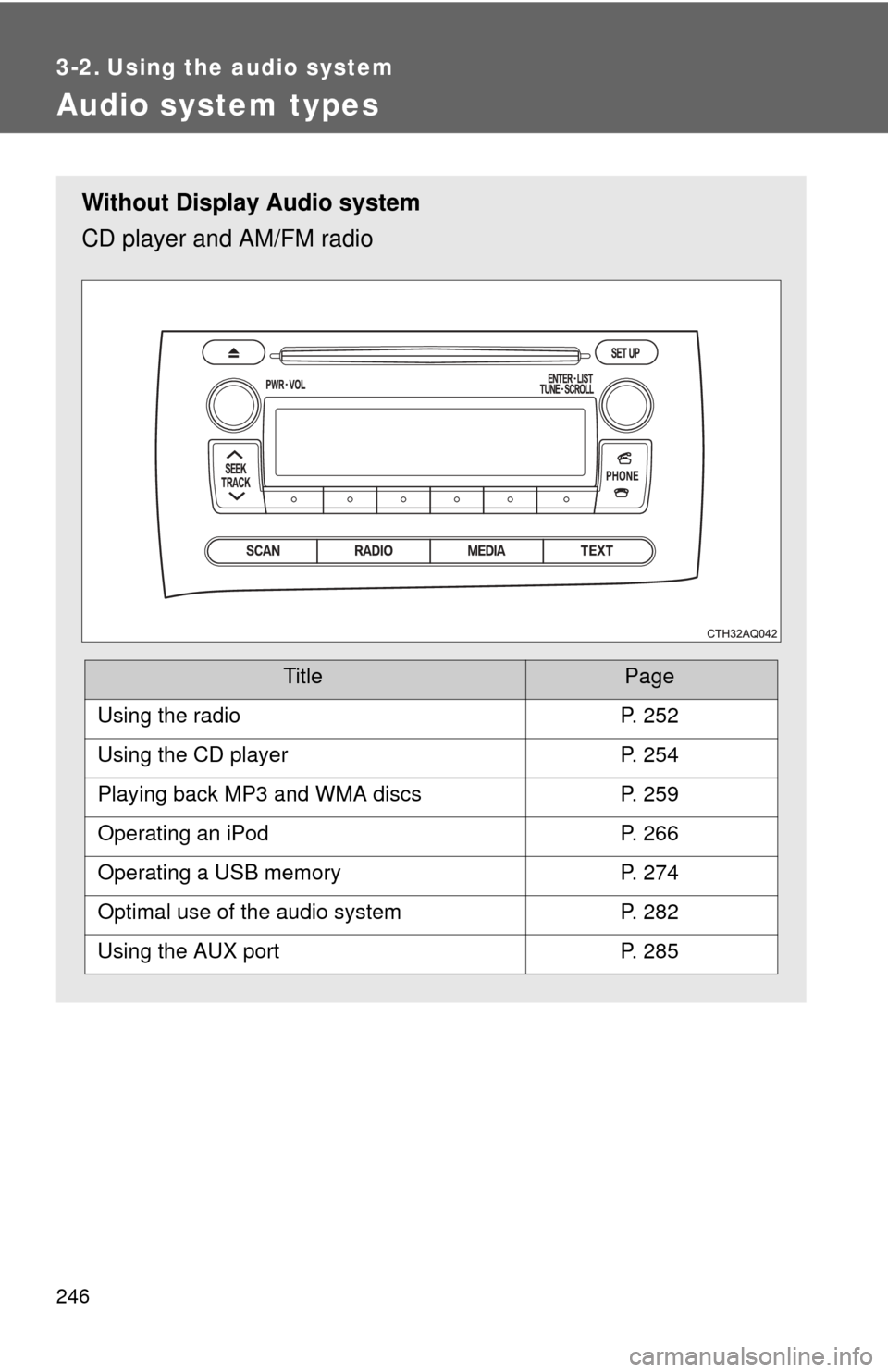
246
3-2. Using the audio system
Audio system types
Without Display Audio system
CD player and AM/FM radio
TitlePage
Using the radioP. 252
Using the CD playerP. 254
Playing back MP3 and WMA discsP. 259
Operating an iPodP. 266
Operating a USB memoryP. 274
Optimal use of the audio systemP. 282
Using the AUX portP. 285
Page 247 of 556
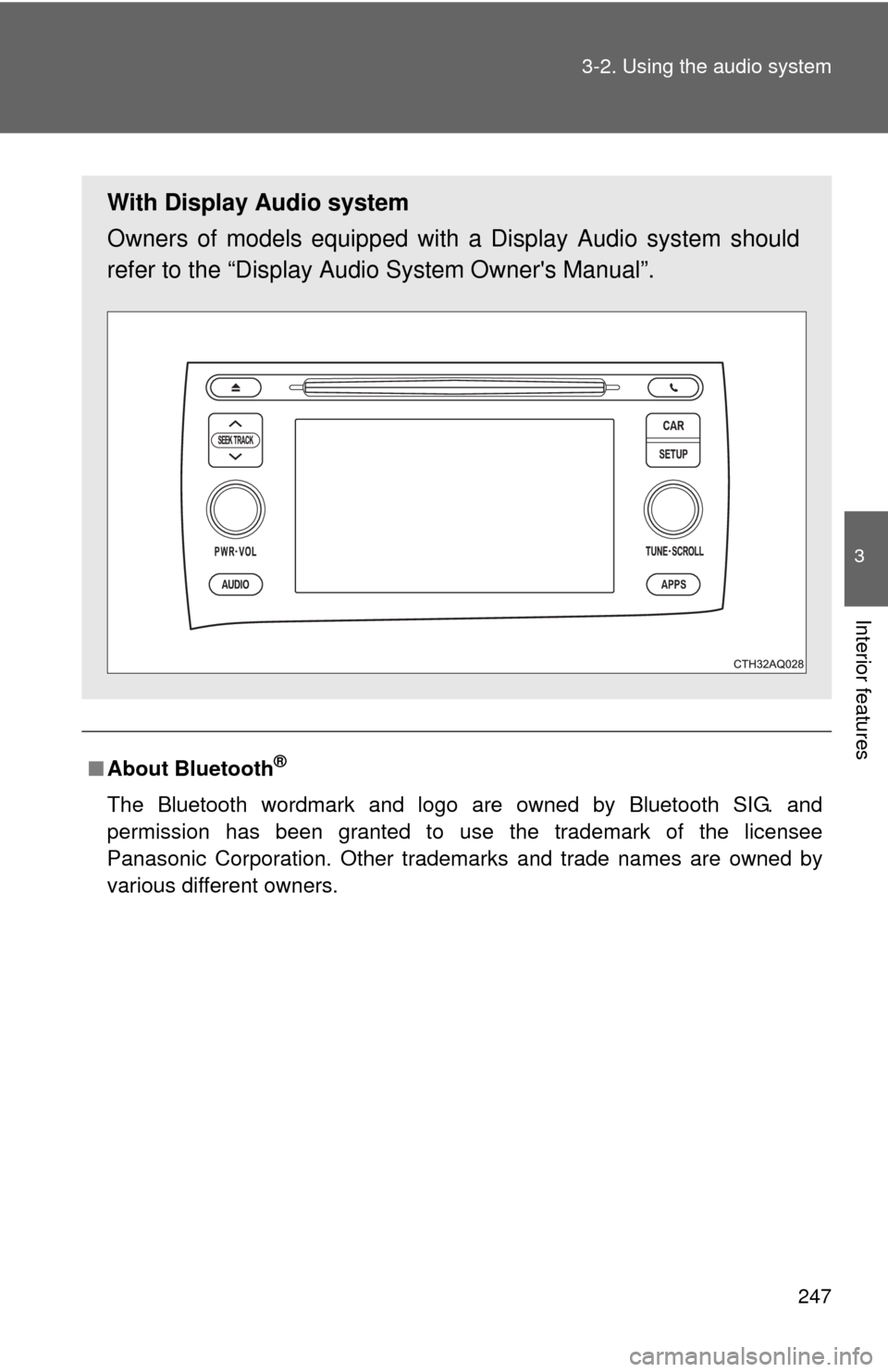
247
3-2. Using the audio system
3
Interior features
â
About Bluetooth®
The Bluetooth wordmark and logo are owned by Bluetooth SIG. and
permission has been granted to use the trademark of the licensee
Panasonic Corporation. Other trademarks and trade names are owned by
various different owners.
With Display Audio system
Owners of models equipped with a Display Audio system should
refer to the âDisplay Audio System Owner's Manualâ.
Page 248 of 556
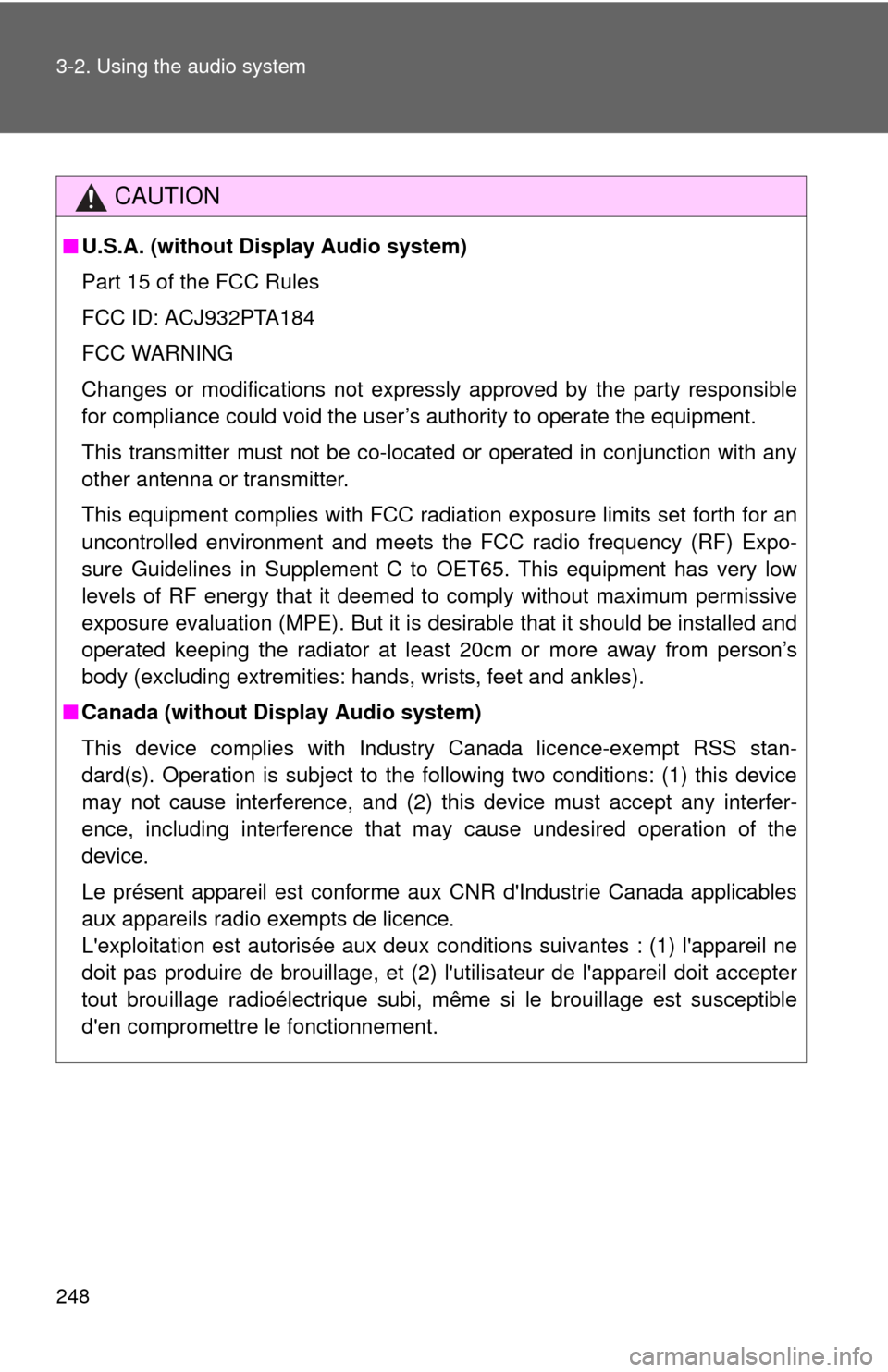
248 3-2. Using the audio system
CAUTION
â U.S.A. (without Display Audio system)
Part 15 of the FCC Rules
FCC ID: ACJ932PTA184
FCC WARNING
Changes or modifications not expressly approved by the party responsible
for compliance could void the userâs authority to operate the equipment.
This transmitter must not be co-located or operated in conjunction with any
other antenna or transmitter.
This equipment complies with FCC radiation exposure limits set forth for an
uncontrolled environment and meets the FCC radio frequency (RF) Expo-
sure Guidelines in Supplement C to OET65. This equipment has very low
levels of RF energy that it deemed to comply without maximum permissive
exposure evaluation (MPE). But it is desirable that it should be installed and
operated keeping the radiator at least 20cm or more away from personâs
body (excluding extremities: hands, wrists, feet and ankles).
â Canada (without Display Audio system)
This device complies with Industry Canada licence-exempt RSS stan-
dard(s). Operation is subject to the following two conditions: (1) this device
may not cause interference, and (2) this device must accept any interfer-
ence, including interference that may cause undesired operation of the
device.
Le présent appareil est conforme aux CNR d'Industrie Canada applicables
aux appareils radio exempts de licence.
L'exploitation est autorisée aux deux conditions suivantes : (1) l'appareil ne
doit pas produire de brouillage, et (2) l'utilisateur de l'appareil doit accepter
tout brouillage radioélectrique subi, même si le brouillage est susceptible
d'en compromettre le fonctionnement.
Page 249 of 556
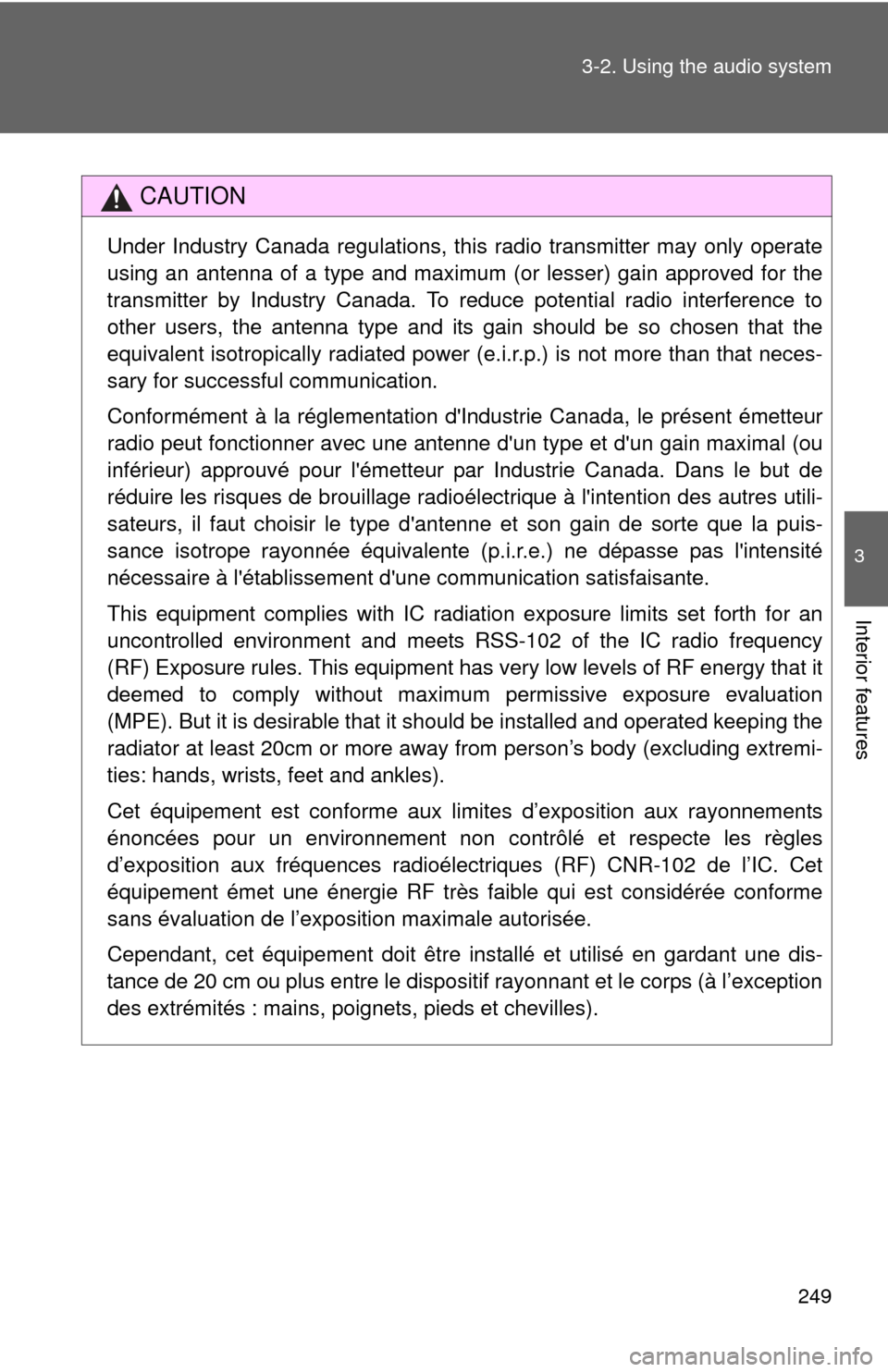
249
3-2. Using the audio system
3
Interior features
CAUTION
Under Industry Canada regulations, this radio transmitter may only operate
using an antenna of a type and maximum (or lesser) gain approved for the
transmitter by Industry Canada. To reduce potential radio interference to
other users, the antenna type and its gain should be so chosen that the
equivalent isotropically radiated power (e.i.r.p.) is not more than that neces-
sary for successful communication.
Conformément à la réglementation d'Industrie Canada, le présent émetteur
radio peut fonctionner avec une antenne d'un type et d'un gain maximal (ou
inférieur) approuvé pour l'émetteur par Industrie Canada. Dans le but de
réduire les risques de brouillage radioélectrique à l'intention des autres utili-
sateurs, il faut choisir le type d'antenne et son gain de sorte que la puis-
sance isotrope rayonnée équivalente (p.i.r.e.) ne dépasse pas l'intensité
nécessaire à l'établissement d'une communication satisfaisante.
This equipment complies with IC radiation exposure limits set forth for an
uncontrolled environment and meets RSS-102 of the IC radio frequency
(RF) Exposure rules. This equipment has very low levels of RF energy that it
deemed to comply without maximum permissive exposure evaluation
(MPE). But it is desirable that it should be installed and operated keeping the
radiator at least 20cm or more away from personâs body (excluding extremi-
ties: hands, wrists, feet and ankles).
Cet équipement est conforme aux limites dâexposition aux rayonnements
énoncées pour un environnement non contrôlé et respecte les règles
dâexposition aux fréquences radioélectriques (RF) CNR-102 de lâIC. Cet
équipement émet une énergie RF très faible qui est considérée conforme
sans évaluation de lâexposition maximale autorisée.
Cependant, cet équipement doit être installé et utilisé en gardant une dis-
tance de 20 cm ou plus entre le dispositif rayonnant et le corps (Ã lâexception
des extrémités : mains, poignets, pieds et chevilles).
Page 250 of 556
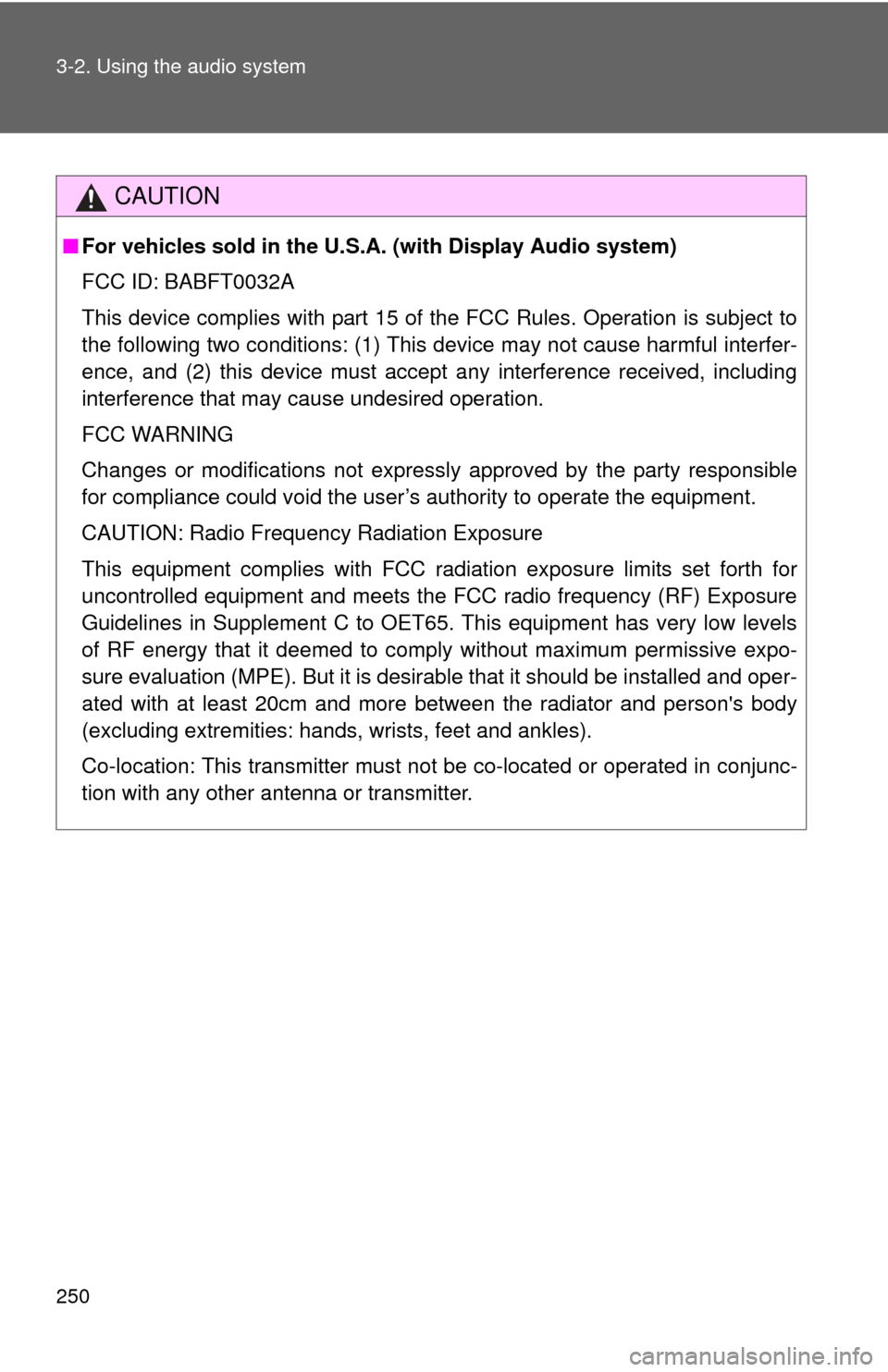
250 3-2. Using the audio system
CAUTION
â For vehicles sold in the U.S.A. (with Display Audio system)
FCC ID: BABFT0032A
This device complies with part 15 of the FCC Rules. Operation is subject to
the following two conditions: (1) This device may not cause harmful interfer-
ence, and (2) this device must accept any interference received, including
interference that may cause undesired operation.
FCC WARNING
Changes or modifications not expressly approved by the party responsible
for compliance could void the userâs authority to operate the equipment.
CAUTION: Radio Frequency Radiation Exposure
This equipment complies with FCC radiation exposure limits set forth for
uncontrolled equipment and meets the FCC radio frequency (RF) Exposure
Guidelines in Supplement C to OET65. This equipment has very low levels
of RF energy that it deemed to comply without maximum permissive expo-
sure evaluation (MPE). But it is desirable that it should be installed and oper-
ated with at least 20cm and more between the radiator and person's body
(excluding extremities: hands, wrists, feet and ankles).
Co-location: This transmitter must not be co-located or operated in conjunc-
tion with any other antenna or transmitter.